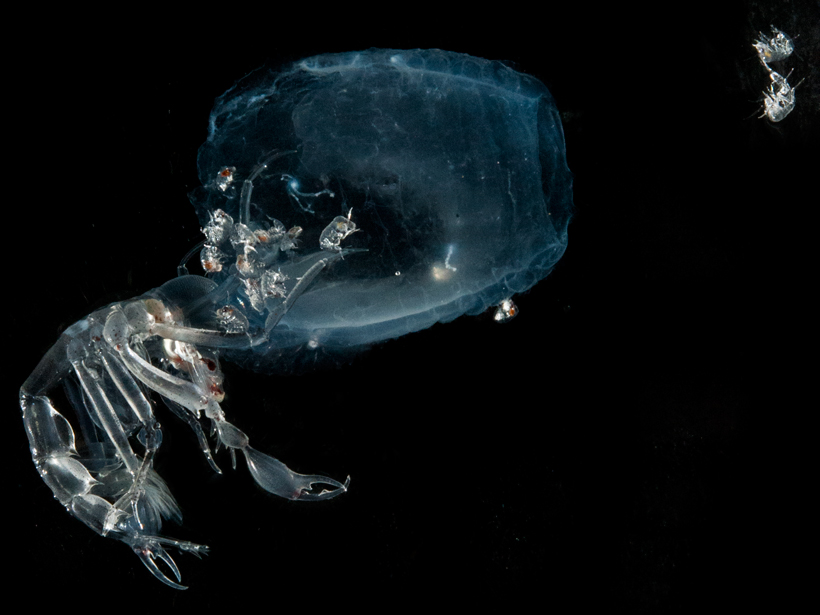Methane seeps are hot spots of unanswered questions from nearly all fields of oceanography.
Last summer, 24 early-career scientists explored deep-sea methane seeps, climatically important areas of natural methane release on the seafloor, as part of the first University National Oceanographic Laboratory System (UNOLS) Deep Submergence Training Cruise. Methane seeps are interfaces between complex geological and biological processes and can harbor expansive carbonate crusts, carpets of white sulfide-oxidizing bacterial mats, complex chemosynthetic ecosystems, and cascades of ascending methane bubbles. Seeps are also hot spots of unanswered questions from nearly all fields of oceanography.
Over the course of a 14-day program, the group investigated six such seeps, located 215 kilometers southeast of Woods Hole, Mass. The sites are part of a recently discovered series of nearly 600 seeps extending from Massachusetts to South Carolina. The group explored these seeps while learning how to use two of the National Deep Submergence Facility’s most precise sampling assets: the human-occupied vehicle (HOV) Alvin and the autonomous underwater vehicle Sentry. The chemical makeup of these regions can vary significantly over a small area, making precision sampling a necessity.

The cruise focused on the geological, biological, and chemical characterization of the seeps. The early-career participants, including graduate students, postdocs, assistant professors, and associate professors, designed a sampling plan that included nine Alvin dives and five Sentry dives, as well as ship-based sediment coring, camera tows, bathymetric mapping, and water sampling.
Participants, divided into two groups, spent half the cruise on board the R/V Atlantis and half the cruise participating via telepresence from the Inner Space Center at the University of Rhode Island. Live video and audio feeds to each meeting room and laboratory on the ship enabled the shore-based team to contribute to sample collection and processing decisions in real time. This allowed the involvement of more participants and therefore more expertise to guide the highly interdisciplinary shipboard sampling effort. Telepresence also facilitated several outreach efforts during the cruise, including live Q&A sessions with student groups across the country, extending the impact of the program beyond the participants present.
In total, participants collected 288 sediment, water, rock, and animal samples, in addition to more than 30,000 seafloor images and more than 100 hours of video. In addition to seafloor sampling with Alvin, observations and collections were also performed in the water column on two Alvin dives, including the recovery of plankton at water depths between 100 and 1000 meters. Midwater work is an underused capability of Alvin, and its success on this cruise highlights its potential utility on future expeditions.
Participants visually confirmed active methane bubbling and robust chemosynthetic ecosystems at all of the visited sites that previous acoustic water column mapping identified as cold seeps. The samples and data sets were divided among the cruise participants, who will continue to analyze the geochemistry, mineralogy, microbiology, and macrofauna over the coming months. Already, one participant has identified a new species of invertebrate and has begun its characterization, as seen in the video below.
University of Alabama scientist finds new species on ocean floor.
The data from this cruise will yield several peer-reviewed publications and serve as preliminary data for future deep-sea research proposals written by the participants.
More information about future UNOLS early-career programs can be found on the UNOLS website. We thank the program mentors, Cindy Van Dover, Dan Fornari, Adam Soule, Donna Blackman, and Karl Bates, the Alvin and Sentry teams, and the crew of R/V Atlantis AT36. The cruise was funded by the National Science Foundation (award NSF OCE 1641453).
—Anne E. Dekas (email: [email protected]), School of Earth, Energy, and Environmental Sciences, Stanford University, Calif.; and Adam Skarke, Department of Geosciences, Mississippi State University, Mississippi State
Citation:
Dekas, A. E., A. Skarke (2017), Early-career scientists explore newly discovered methane seeps, Eos, 98, https://doi.org/10.1029/2017EO068011. Published on 10 March 2017.
Text © 2017. The authors. CC BY-NC-ND 3.0
Except where otherwise noted, images are subject to copyright. Any reuse without express permission from the copyright owner is prohibited.

